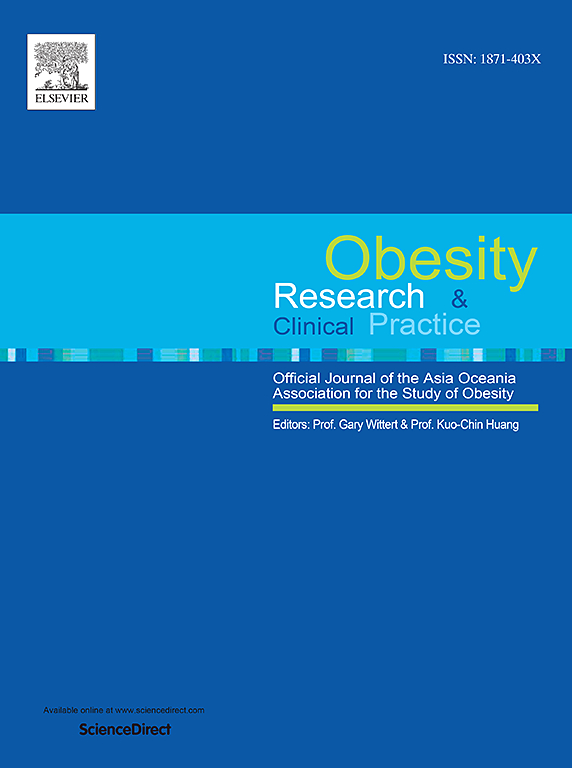Understanding the association of longitudinal body mass index patterns in children and their parents: A data-driven study from the TARGet Kids! cohort
IF 2.5
4区 医学
Q3 ENDOCRINOLOGY & METABOLISM
引用次数: 0
Abstract
Background
Obesity remains a persistent global health issue across generations. Targeting family-level factors may help improve child and adolescent body mass index (BMI) outcomes. While associations between parental and offspring BMI are well-documented, the temporal patterns and risk factors driving these relationships remain unclear. This study aimed to identify longitudinal family-level BMI patterns incorporating child, maternal, and paternal BMI and apply interpretable machine learning (ML) methods to uncover key predictors.
Methods
This longitudinal study included 6092 children and their parents from the TARGet Kids! cohort, with BMI measurements collected from birth to 150 months. Group-based multi-trajectory modeling identified joint trajectories of child BMI-for-age Z-scores (zBMI) and parental BMI. Five ML classifiers predicted group membership using 78 predictors spanning sociodemographic, dietary, parental health, and child lifestyle variables. To explore the modifying effect of parental overweight/obesity (OW/OB) on the relationship between child age and BMI, Bayesian generalized additive mixed models (GAMMs) with smoothed term interactions were applied.
Results
Five distinct joint trajectory groups were identified. Children in the highest BMI trajectory group typically had both parents following similar high BMI trajectories. Parental OW/OB status emerged as the strongest predictor of child OW/OB (37 % classification probability), followed by breastfeeding duration (17 %) and child physical activity (15 %). The influence of parental OW/OB was particularly pronounced in early childhood (0–60 months). Bayesian GAMMs confirmed the robust, longitudinal association between child and parental BMI trajectories.
Conclusions
Parental BMI patterns strongly influence child BMI development, with age-dependent effects. These findings highlight the importance of early family-based interventions.
了解儿童及其父母纵向体重指数模式的关联:一项来自目标儿童的数据驱动研究!队列。
背景:肥胖仍然是一个跨越几代人的全球性健康问题。针对家庭水平的因素可能有助于改善儿童和青少年的身体质量指数(BMI)结果。虽然父母和后代的体重指数之间的联系有充分的证据,但推动这些关系的时间模式和风险因素仍不清楚。本研究旨在确定纵向家庭水平的BMI模式,包括儿童、母亲和父亲的BMI,并应用可解释的机器学习(ML)方法来揭示关键预测因素。方法:本纵向研究包括来自目标儿童的6092名儿童及其父母!队列,从出生到150个月收集BMI测量值。基于组的多轨迹模型确定了儿童年龄BMI z分数(zBMI)和父母BMI的联合轨迹。五个ML分类器使用78个预测因子预测群体成员,这些预测因子涵盖社会人口统计学、饮食、父母健康和儿童生活方式变量。为了探讨父母超重/肥胖(OW/OB)对儿童年龄与BMI关系的调节作用,采用平滑项交互作用的贝叶斯广义加性混合模型(GAMMs)。结果:确定了五个不同的关节轨迹组。BMI指数最高组的孩子通常父母双方都遵循相似的高BMI轨迹。父母OW/OB状态是儿童OW/OB的最强预测因子(37 %分类概率),其次是母乳喂养时间(17 %)和儿童身体活动(15 %)。父母OW/OB的影响在儿童早期(0-60个月)尤为明显。贝叶斯GAMMs证实了孩子和父母的BMI轨迹之间强有力的纵向关联。结论:父母BMI模式强烈影响儿童BMI发展,且具有年龄依赖性。这些发现强调了早期家庭干预的重要性。
本文章由计算机程序翻译,如有差异,请以英文原文为准。
求助全文
约1分钟内获得全文
求助全文
来源期刊

Obesity research & clinical practice
医学-内分泌学与代谢
CiteScore
7.10
自引率
0.00%
发文量
80
审稿时长
49 days
期刊介绍:
The aim of Obesity Research & Clinical Practice (ORCP) is to publish high quality clinical and basic research relating to the epidemiology, mechanism, complications and treatment of obesity and the complication of obesity. Studies relating to the Asia Oceania region are particularly welcome, given the increasing burden of obesity in Asia Pacific, compounded by specific regional population-based and genetic issues, and the devastating personal and economic consequences. The journal aims to expose health care practitioners, clinical researchers, basic scientists, epidemiologists, and public health officials in the region to all areas of obesity research and practice. In addition to original research the ORCP publishes reviews, patient reports, short communications, and letters to the editor (including comments on published papers). The proceedings and abstracts of the Annual Meeting of the Asia Oceania Association for the Study of Obesity is published as a supplement each year.
 求助内容:
求助内容: 应助结果提醒方式:
应助结果提醒方式:


